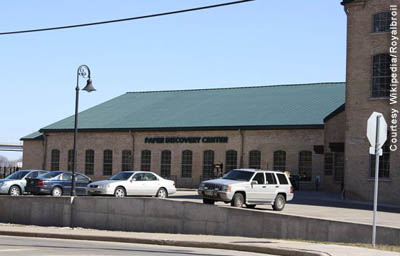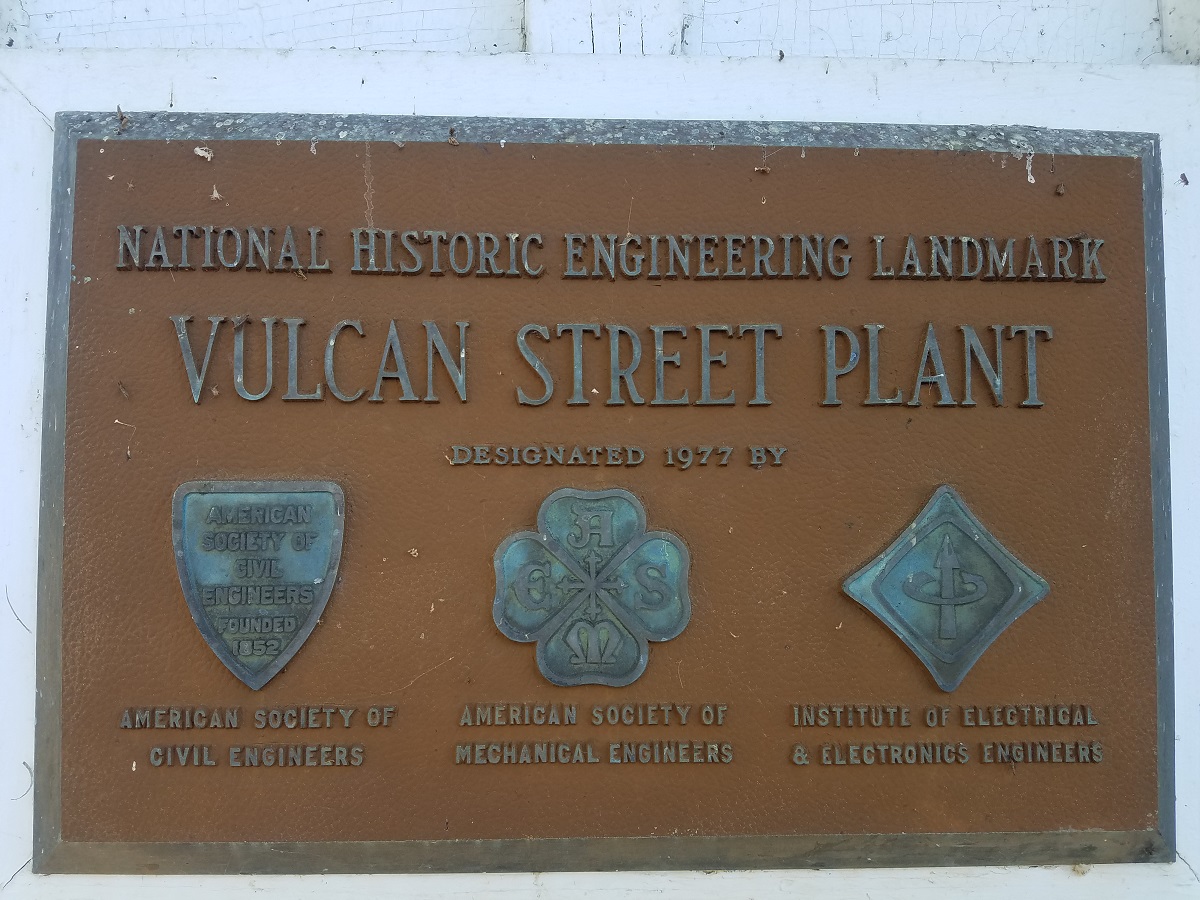Vulcan Street Plant
44 15 29.2 N
88 23 50.2 W

"Mr. H.J. Rogers is a man who ordinarily deals in heavy things, such as his paper and pulp mills. Within the past few days, however, he has changed his tactics, or rather ... he has gone in for light transactions. He has purchased the exclusive right for illuminating the towns of the Fox River Valley with the Edison electric lamp."
- The Appleton Post, July 27, 1882
By 1880, Thomas Edison had already demonstrated his system for generating electricity with low-resistance generators that delivered power to low-resistance incandescent bulbs. One of the first locations for the application of Edison's demonstration was Appleton, Wisconsin, located on the Fox River just 30 miles southwest of Green Bay. On September 30, 1882, the Vulcan Street Plant in the Appleton Pulp Mill became the first central-station plant in the world to generate electricity by combining the latest advances in hydro-power sites with one of Edison's new electrical generators.
The Edison Company had already begun to generate electricity with steam power 26 days earlier at its Pearl Street plant in New York City, but steam-generated electricity proved more expensive. Within four years of Appleton's pioneering effort, nearly 50 hydroelectric generating projects were announced throughout North America and, by the turn of the century, hydroelectric power accounted for more than 40 percent of the United States' total electricity supply.
When it began operation, the Vulcan Street Plant was the first Edison hydroelectric central station to serve a system of private and commercial customers in North America. This project was the beginning of cooperation among civil, mechanical, and electrical engineers to provide power for the United States.
"Mr. H.J. Rogers is a man who ordinarily deals in heavy things, such as his paper and pulp mills. Within the past few days, however, he has changed his tactics, or rather ... he has gone in for light transactions. He has purchased the exclusive right for illuminating the towns of the Fox River Valley with the Edison electric lamp."
- The Appleton Post, July 27, 1882
By 1880, Thomas Edison had already demonstrated his system for generating electricity with low-resistance generators that delivered power to low-resistance incandescent bulbs. One of the first locations for the application of Edison's demonstration was Appleton, Wisconsin, located on the Fox River just 30 miles southwest of Green Bay. On September 30, 1882, the Vulcan Street Plant in the Appleton Pulp Mill became the first central-station plant in the world to generate electricity by combining the latest advances in hydro-power sites with one of Edison's new electrical generators.
The Edison Company had already begun to generate electricity with steam power 26 days earlier at its Pearl Street plant in New York City, but steam-generated electricity proved more expensive. Within four years of Appleton's pioneering effort, nearly 50 hydroelectric generating projects were announced throughout North America and, by the turn of the century, hydroelectric power accounted for more than 40 percent of the United States' total electricity supply.
Facts
- The Vulcan Street Plant was unique in linking a relatively sophisticated water-supply system -- consisting of flumes, wooden penstocks, and head-gate controls installed to regulate the water pressure powering the plant's turbines -- with the ongoing development of Edison generating systems to successfully demonstrate the practical application of water power in generating electrical power.
- The driving force behind Appleton's entry into the age of electricity was Henry J. Rogers, a wealthy industrialist who owned the Appleton Pulp Mill, the Appleton Paper Mill, and the Appleton Gas Light Company. After learning from a friend that the Western Edison Electric Light Company had recently begun granting exclusive rights to build Edison plants in cities throughout Illinois, Iowa, and Wisconsin, Rogers put together a group of investors to secure rights for plants in the Fox River valley.
- The first electricity produced from the Vulcan Street Plant went to light several industrial buildings as well as Rogers' impressive, new Victorian home built on a bluff overlooking the river -- which led skeptics to suggest that perhaps Rogers was primarily motivated by a desire to equip his own home with "all the latest conveniences."
- An exact replica of the orginal building on Vulcan Street, abandoned in the late 1880s, was built in 1932 to celebrate its 50th anniversary. The home of Henry Rogers -- the first residence in the world lit from a central hydroelectric plant -- was restored, with the original Edison switches and chandeliers still in place, and has been designated a Wisconsin historic site.


